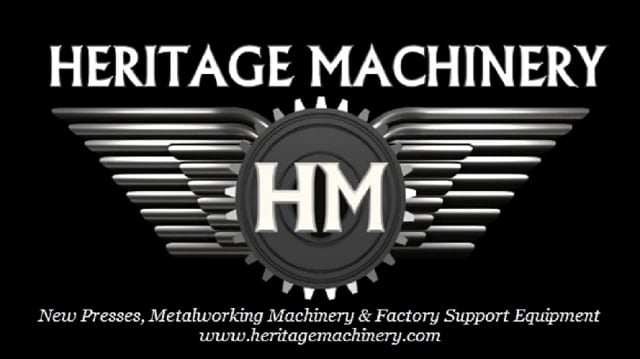Thick Metal Sanding and Finishing Machines
Systems Manufactured to Tackle Surface Finishing of The Most Challenging Thick Metal Plates.
WEBER PT
Deburring machine for laser cut, punched and nibbled parts
``````````The WEBER PT is a new generation universal grinding machine for deburring, rounding, descaling and surface grinding of thin sheets and heavy plates. Up to 5 grinding stations allow for all machining variations. A CBF station can be installed for a perfect surface finish. The STC bolt grinding beam is available especially for flame-cut and plasma-cut heavy plates.
WEBER PT – advantages at a glance:
- New modern design
- New simplified operating structure through WEBER i-Touch with its faster and more easily accessible operating panel
- Larger and variable grinding belt length
- Laterally extendible planetary head unit and MRB unit for improved integration into production lines
- Improved accessibility for maintenance
- Replaceable units through the modular design for improved
flexibility in case of changing requirements - Simultaneous machining top/bottom as an option
WEBER PT Technical Data
|
Operating height 900 mm |
Version with 1 to 5 grinding stations |
|
Workpiece thickness 0.3–100 mm |
Infinitely adjustable feed speed (1–10 m/min) |
|
Grinding belt length 2150 or 2620 mm |
"i-Touch“-controller |
|
Multi Panel TP 900 comfort (or higher) |
Grinding belt drive up to 24 kW |
|
Flexible arrangement of the grinding stations |
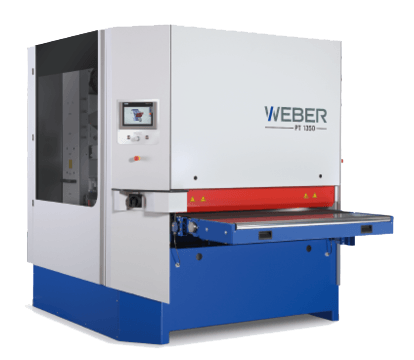
K Combination Grinding Beam
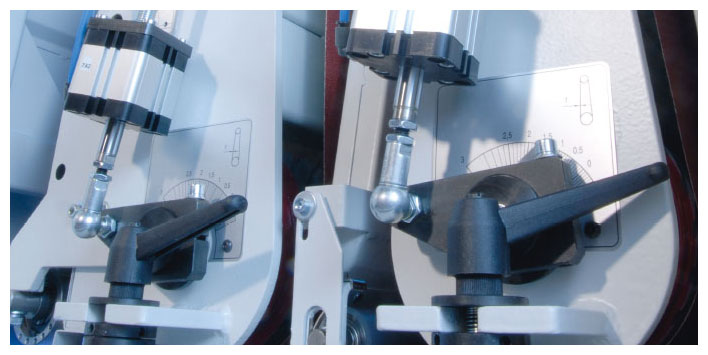
WEBER K Combination unit
Plates of different thickness are cut by means of different procedures and with different cutting parameters. Furthermore, plates of different thickness have different characteristics, which influence burr formation. The thicker a plate, the greater the thickness differences after cutting, due to warping and burr formation.
WEBER has been offering a solution to this problem for several years. The advantages offered by a flexible grinding beam and the performance of a grinding roller - optimized and combined in one grinding station – yield perfect results.
Grinding Roller
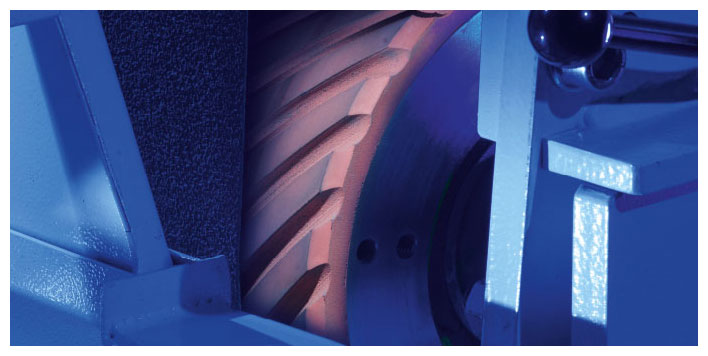
WEBER GD Grinding roller
For surface finishing, WEBER uses its GD grinding roller: A perfect surface finish and ideal deburring are achieved in a single operating sequence. The grinding pressure is generated by positioning the roller downwards below the zero level. When the roller approaches the workpieces, the rubber coating of the roller is pushed inwards. The restoring force of the roller is thus the grinding force. Grinding rollers are available with different diameters and rubber hardness and can be adapted to all parts to be ground.
Planetary Head
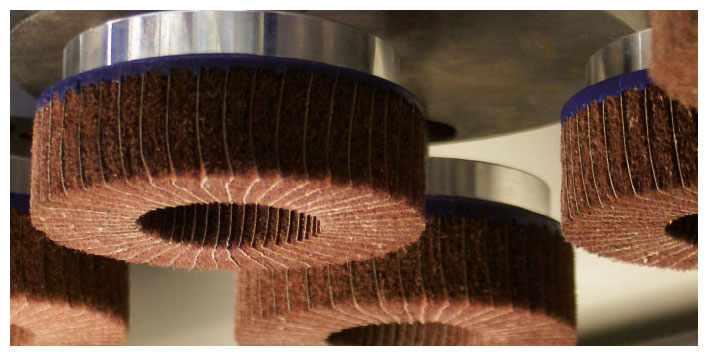
WEBER DR Planetary head
WEBER uses its planetary head technology for all-round edge machining with cup brushes. In this process, several rotating brushes arranged in groups are given an additional turning motion. This means that the brushes work at the ideal angle on the workpiece. In the patented WEBER solution, the tools of adjacent heads overlap in a way that ensures that there are no gaps during machining. As an alternative, we at WEBER also construct a two-row arrangement in which each tool carrier is equipped with six brushes.
Bolt Grinding Beam
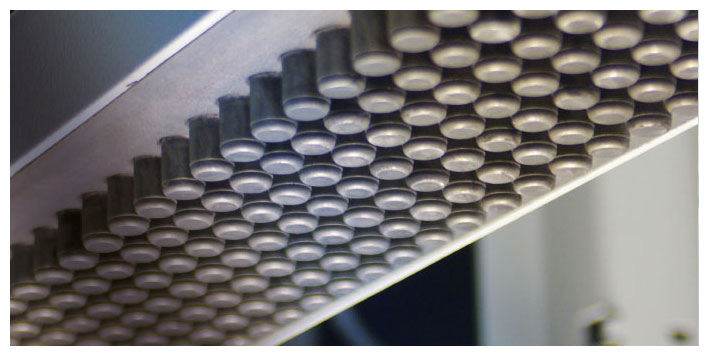
WEBER STC Bolt grinding beam
With this grinding beam system, WEBER has taken machining of thick and uneven plates to a new level: A constant grinding quality, a high material throughput and low operating costs due to a high grinding belt operating life are characteristic for this technology. This function is simple, but well conceived. The grinding belt is pre-tensioned downward by a few millimetres and held in a flat position. Due to the long contact surfaces with the workpieces, it makes a stronger impact on all edges without creating secondary burrs. The pre-tension compensates for existing thickness differences between one part and another by itself and therefore makes economic multiple feeding possible – an enormous advantage, especially for small parts.
Brush Rollers
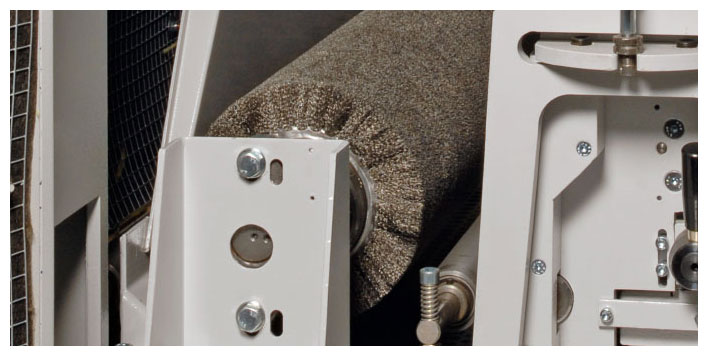
WEBER BS Brush rollers
The BS brush rollers are used for removing secondary burrs after grinding or milling. They machine the surface and to some extent the edges. For system-related reasons, the rounding action is much more effective on the transverse edges than on the longitudinal edges that are barely rounded. The BS brush rollers improve the surface quality, change the surface roughness or surface structure. They also make it possible to remove material residue after grinding or milling without damaging the surface.
Brush System
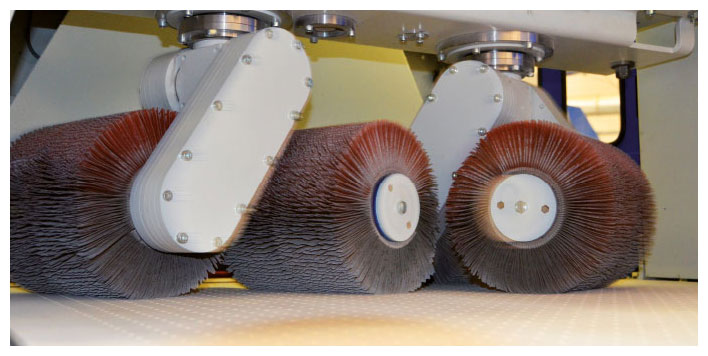
WEBER MRB Brush system
When round brushes are used, several rotating heads are also arranged next to each other. The meshing of the brushes during the combing procedure and two brushes per head create even machining results along the entire operating width. The modular design of the brush heads allows for problem-free machining of each part with the procedure it requires. This arrangement works perfectly for any material thickness starting from one millimeter.
CBF Grinding Beam
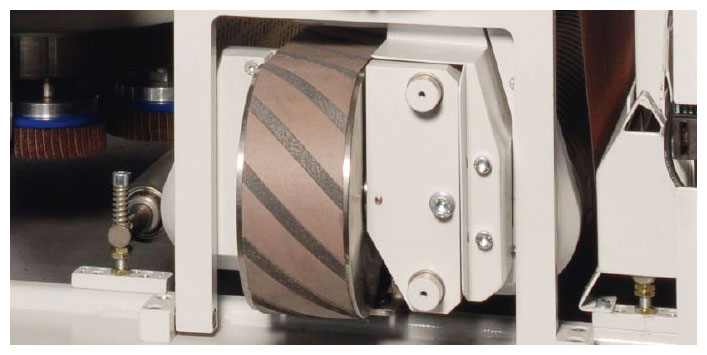
CBF Grinding beams
The patented WEBER CBF system presses the grinding belt against the workpiece via a segmented grinding beam. In this way, diverse grinding patterns are possible with an easily adjustable line length. Even machining thicker metal sheets is no problem for this system – and it is all accomplished with a longer grinding belt service life and lower material heating.
WEBER TTSC
Deburring machine for laser cut, punched and nibbled parts
The TTSC model range is the most compact of all WEBER grinding machines. With three processing statins, a wide variety of applications can be covered. Deburring at high feed rates, rounding up to R2, surface grinding, sheets with holes, foil-coated sheets, deburring or descaling of cut edges.
WEBER TTSC Technical Data
|
Working widths 1100 and 1350 mm |
Grinding belt length 1900 mm |
|
Working height 800-900 mm (variable) |
Infinitely adjustable feed speed (1–10 m/min) |
|
Version with 3 grinding stations |
"i-Touch“-controller |
|
Workpiece thickness 0.3 -100 mm |
Grinding belt drive up to 19 kW |
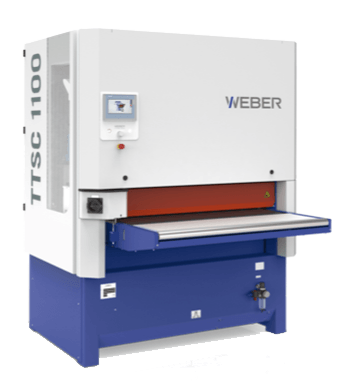
Grinding Roller

WEBER GD Grinding roller
For surface finishing, WEBER uses its GD grinding roller: A perfect surface finish and ideal deburring are achieved in a single operating sequence. The grinding pressure is generated by positioning the roller downwards below the zero level. When the roller approaches the workpieces, the rubber coating of the roller is pushed inwards. The restoring force of the roller is thus the grinding force. Grinding rollers are available with different diameters and rubber hardness and can be adapted to all parts to be ground.
Planetary Head

WEBER DR Planetary head
For surface finishing, WEBER uses its GD grinding roller: A perfect surface finish and ideal deburring are achieved in a single operating sequence. The grinding pressure is generated by positioning the roller downwards below the zero level. When the roller approaches the workpieces, the rubber coating of the roller is pushed inwards. The restoring force of the roller is thus the grinding force. Grinding rollers are available with different diameters and rubber hardness and can be adapted to all parts to be ground.
Bolt Grinding Beam

WEBER STC Bolt grinding beam
For surface finishing, WEBER uses its GD grinding roller: A perfect surface finish and ideal deburring are achieved in a single operating sequence. The grinding pressure is generated by positioning the roller downwards below the zero level. When the roller approaches the workpieces, the rubber coating of the roller is pushed inwards. The restoring force of the roller is thus the grinding force. Grinding rollers are available with different diameters and rubber hardness and can be adapted to all parts to be ground.
WEBER PT K
Deburring machine for flame-cut and plasma-cut parts
The PT K model range is the compact version of the PT series. Deburring, rounding and descaling of of thick and considerably warped plates and sheet metal parts is no problem for the PT K. Deburring is performed by the WEBER STC bolt grinding beam. Should the parts require edge rounding after deburring, additional stations, such as the WEBER DR planetary head or the WEBER MRB multi-rotation brush, can also be integrated.
WEBER PT K Technical Data
|
Working widths 600, 1100, 1350 and 1600 mm |
Grinding belt length 2150 mm |
|
Working height 850 mm (constant) |
Grinding belt drive up to 22 kW |
|
Version with 1 to 3 grinding stations |
Multi Panel MP 377 |
|
Workpiece thickness 1-100 mm |
“i-Touch” controller |
|
Infinitely variable feed speed (1-10 m/min) |
Freely selectable arrangement |
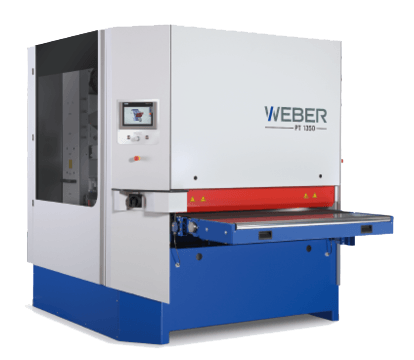
Grinding Roller

WEBER GD Grinding roller
For surface finishing, WEBER uses its GD grinding roller: A perfect surface finish and ideal deburring are achieved in a single operating sequence. The grinding pressure is generated by positioning the roller downwards below the zero level. When the roller approaches the workpieces, the rubber coating of the roller is pushed inwards. The restoring force of the roller is thus the grinding force. Grinding rollers are available with different diameters and rubber hardness and can be adapted to all parts to be ground.
Planetary Head

WEBER DR Planetary head
WEBER uses its planetary head technology for all-round edge machining with cup brushes. In this process, several rotating brushes arranged in groups are given an additional turning motion. This means that the brushes work at the ideal angle on the workpiece. In the patented WEBER solution, the tools of adjacent heads overlap in a way that ensures that there are no gaps during machining. As an alternative, we at WEBER also construct a two-row arrangement in which each tool carrier is equipped with six brushes.
Bolt Grinding Beam

WEBER STC Bolt grinding beam
With this grinding beam system, WEBER has taken machining of thick and uneven plates to a new level: A constant grinding quality, a high material throughput and low operating costs due to a high grinding belt operating life are characteristic for this technology. This function is simple, but well conceived. The grinding belt is pre-tensioned downward by a few millimetres and held in a flat position. Due to the long contact surfaces with the workpieces, it makes a stronger impact on all edges without creating secondary burrs. The pre-tension compensates for existing thickness differences between one part and another by itself and therefore makes economic multiple feeding possible – an enormous advantage, especially for small parts.
Brush Rollers

WEBER BS Brush rollers
The BS brush rollers are used for removing secondary burrs after grinding or milling. They machine the surface and to some extent the edges. For system-related reasons, the rounding action is much more effective on the transverse edges than on the longitudinal edges that are barely rounded. The BS brush rollers improve the surface quality, change the surface roughness or surface structure. They also make it possible to remove material residue after grinding or milling without damaging the surface.
Brush System

WEBER MRB Brush system
When round brushes are used, several rotating heads are also arranged next to each other. The meshing of the brushes during the combing procedure and two brushes per head create even machining results along the entire operating width. The modular design of the brush heads allows for problem-free machining of each part with the procedure it requires. This arrangement works perfectly for any material thickness starting from one millimeter.
K Combination Grinding Beam

WEBER K Combination unit
Plates of different thickness are cut by means of different procedures and with different cutting parameters. Furthermore, plates of different thickness have different characteristics, which influence burr formation. The thicker a plate, the greater the thickness differences after cutting, due to warping and burr formation.
WEBER has been offering a solution to this problem for several years. The advantages offered by a flexible grinding beam and the performance of a grinding roller - optimized and combined in one grinding station – yield perfect results.
WEBER MK
Deburring machine for flame-cut and plasma-cut parts
The largest and heaviest plates and sheet metal parts pose no problem for the WEBER MK model range. The MK machines the thickest, heaviest and most warped plates and sheet metal parts. With its up to 4 machining stations and extremely sturdy design, the MK deals with even the most solid parts with ease.
WEBER MK Technical Data
|
Working widths 1100, 1350, 1600 and 2000 mm |
Grinding belt length 2620 mm |
|
Working height 900 mm (constant) |
Grinding belt drive up to 30 kW |
|
Version with 1 to 4 grinding stations |
Multi Panel MP 377 |
|
Workpiece thickness 4-120 mm |
“i-Touch” controller |
|
Infinitely variable feed speed (1-10 m/min) |
Freely selectable arrangement |
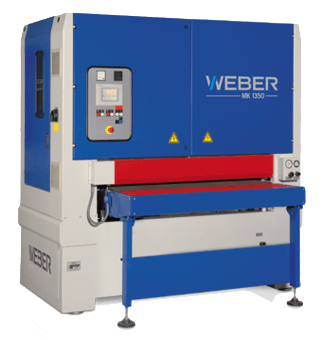
Grinding Roller

WEBER GD Grinding roller
For surface finishing, WEBER uses its GD grinding roller: A perfect surface finish and ideal deburring are achieved in a single operating sequence. The grinding pressure is generated by positioning the roller downwards below the zero level. When the roller approaches the workpieces, the rubber coating of the roller is pushed inwards. The restoring force of the roller is thus the grinding force. Grinding rollers are available with different diameters and rubber hardness and can be adapted to all parts to be ground.
Planetary Head

WEBER DR Planetary head
WEBER uses its planetary head technology for all-round edge machining with cup brushes. In this process, several rotating brushes arranged in groups are given an additional turning motion. This means that the brushes work at the ideal angle on the workpiece. In the patented WEBER solution, the tools of adjacent heads overlap in a way that ensures that there are no gaps during machining. As an alternative, we at WEBER also construct a two-row arrangement in which each tool carrier is equipped with six brushes.
Bolt Grinding Beam
WEBER STC Bolt grinding beam
With this grinding beam system, WEBER has taken machining of thick and uneven plates to a new level: A constant grinding quality, a high material throughput and low operating costs due to a high grinding belt operating life are characteristic for this technology. This function is simple, but well conceived. The grinding belt is pre-tensioned downward by a few millimeters and held in a flat position. Due to the long contact surfaces with the workpieces, it makes a stronger impact on all edges without creating secondary burrs. The pre-tension compensates for existing thickness differences between one part and another by itself and therefore makes economic multiple feeding possible – an enormous advantage, especially for small parts.
Brush Rollers

WEBER BS Brush rollers
The BS brush rollers are used for removing secondary burrs after grinding or milling. They machine the surface and to some extent the edges. For system-related reasons, the rounding action is much more effective on the transverse edges than on the longitudinal edges that are barely rounded. The BS brush rollers improve the surface quality, change the surface roughness or surface structure. They also make it possible to remove material residue after grinding or milling without damaging the surface.
Brush System

WEBER MRB Brush system
When round brushes are used, several rotating heads are also arranged next to each other. The meshing of the brushes during the combing procedure and two brushes per head create even machining results along the entire operating width. The modular design of the brush heads allows for problem-free machining of each part with the procedure it requires. This arrangement works perfectly for any material thickness starting from one millimeter.
K Combination Grinding Beam

WEBER K Combination unit
Plates of different thickness are cut by means of different procedures and with different cutting parameters. Furthermore, plates of different thickness have different characteristics, which influence burr formation. The thicker a plate, the greater the thickness differences after cutting, due to warping and burr formation.
WEBER has been offering a solution to this problem for several years. The advantages offered by a flexible grinding beam and the performance of a grinding roller - optimized and combined in one grinding station – yield perfect results.
WEBER TTF Deburring Machine
Deburring Machine For Flame And Plasma Cut Parts
The largest and heaviest sheets and sheet metal parts are easy for the WEBER TTF series. The TTF processes the thickest, heaviest and most warped sheets and sheet metal parts. With up to 4 processing stations and particularly robust construction, the TTF can handle even the most massive parts with ease.
WEBER TTK Technical Data
|
Working widths 1100 & 1350 mm |
Grinding belt length 2620 mm |
|
Working height 900 mm (constant) |
Grinding belt drive up to 30 kW |
|
Version with 1 to 2 grinding stations |
Multi Panel TP900 Comfort |
|
Workpiece thickness 4-120 mm |
“i-Touch” controller |
|
Infinitely variable feed speed |
Freely selectable arrangement |
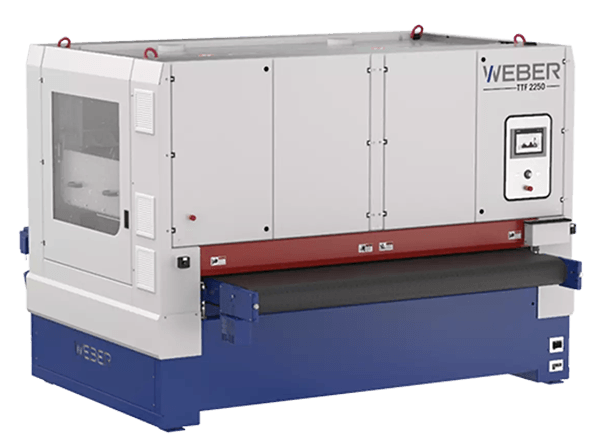
TTK Principal
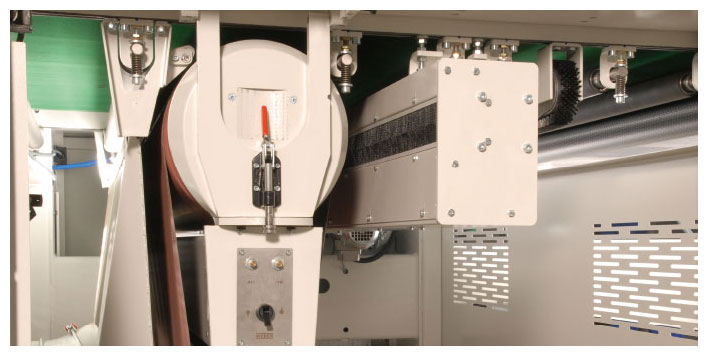
TTK Functional principle
The distinctive feature of the WEBER TTK: our own in-house developed dressing unit for the deburring of coated sheets. This innovation enables deburring and grinding results, which totally satisfy all requirements of the generator manufacturer – without additional expense for the coated sheet manufacturer.
TTK Dressing
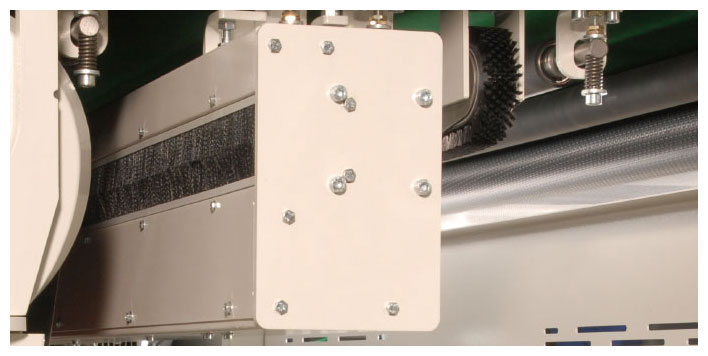
TTK Dressing Unit
A dressing unit, which was specially designed by WEBER for this application, prepares the grinding belt. Handling this is very simple: the belt needs only to be put on to the grinding head, the automatic mode takes care of the rest. The grinding belt can be changed quickly in just a few steps by a single person. Thanks to WEBER technology, the grinding belt lasts several weeks.
